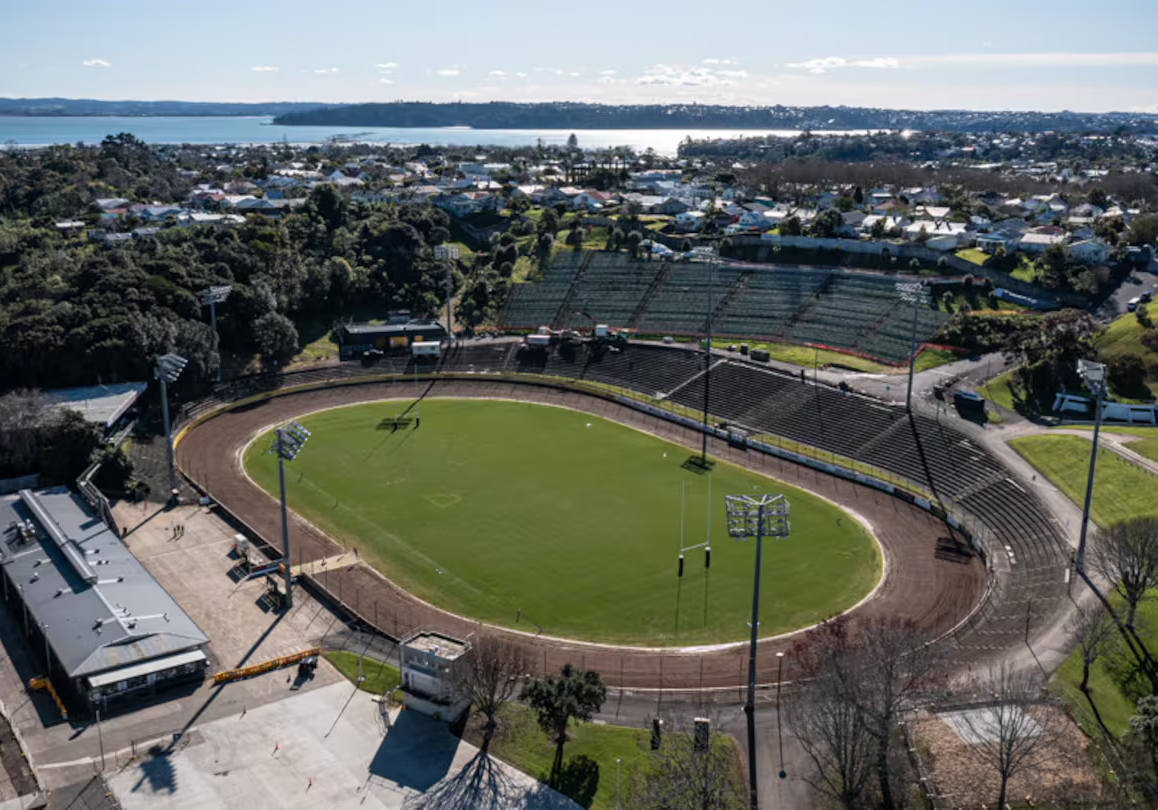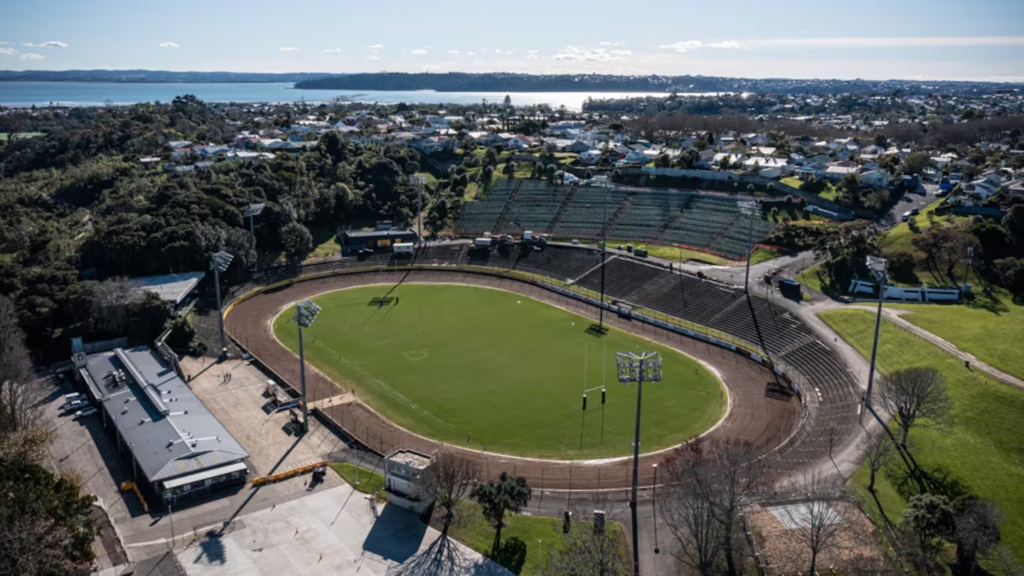What's On > News
A New Era for Western Springs Stadium?
Locals will have plenty memories of our local Western Springs Stadium. Watching Ponsonby Rugby on their home groud, Ripper Rugby with the kids. For years Western Springs has been the local home of speedway. The roar of cars on a summer night.
What about the sound of those legendary concerts and festivals? Bowie, Bono and Bob. Meatloaf, Led Zep, , Six 60, Boz Scaggs, AC/DC, Elton. Rod Stewart, Big Day Out. Laneway and CharliXCX.
Currently the grounds are the base for the Boring Machine (:-)on Watercare’s Central Interceptor project.
Western Springs Stadium is now facing a potential transformation.
The choices are between a modern, football-centric arena, a dedicated music and community sports hub, or maintaining the current setup will have long-lasting implications for the sporting, cultural, and community landscape of Auckland.
Auckland Council, in collaboration with Tātaki Auckland Unlimited (TAU), has opened public consultation on three different options that could redefine the future of this significant site. This consultation, running from May 19th to June 15th, 2025, invites us to share our views on which option we prefer.
The public consultation period provides a vital opportunity for residents to voice their preferences and help shape the next chapter in the story of Western Springs Stadium. Following the consultation, Auckland Council is scheduled to meet on July 31st to review the feedback and analysis before making a decision on the future of this significant Auckland landmark
Option 1: The Auckland Arena
Imagine a state-of-the-art, privately funded multi-purpose venue known as the Auckland Arena. Funded by locals Anna Mowbray and former All Black Ali Williams, co-owners of the city’s new football club, Auckland FC, this option centers around a new 12,500 to 15,000-seat stadium. This stadium would not only serve as the home ground for Auckland FC but also function as a concert venue.
As well as a stadium the Auckland Arena proposal includes:
- high-performance training facilities and fields,
- indoor basketball courts
- football fields
- padel courts
A key aspect of this proposal is that the initial construction and ongoing maintenance would be covered by the proposers, with ownership of the built infrastructure transferring to TAU at the end of a long-term lease (50 years with two 25-year renewal rights). Initial assessments suggest this could significantly reduce the need for public funding compared to other two scenarios.
Option 2: The Western Springs Bowl
This option focuses on enhancing the site’s natural amphitheater to create a premier Hollywood Bowl style live music concert and festival venue with a 50,000-person capacity. This proposal includes new permanent staging infrastructure and upgrades to concert facilities on the outer fields.
The Hollywood Bowl
This option also proposes the development of a 5,000 to 8,000-seat stadium, allowing the facility to cater to a broader range of community and semi-professional sports. Ponsonby Rugby Club, a long-term tenant, would renew its current lease.
This proposal requires a mix of upfront private sector investment and Auckland Council capital investment, with TAU retaining ownership of the site under an initial 30-year lease with two 10-year renewal rights. Initial estimates suggest this option could result in an additional cost to ratepayers over 50 years due to ongoing operation and maintenance.
Option 3: Maintaining the Status Quo or Exploring Other Ideas
The third option considers retaining the existing arrangements, which includes potentially extending the lease with Ponsonby Rugby Club (currently expiring in 2027) and TAU continuing to manage the venue for concerts and festivals. This option also leaves the door open to exploring alternative ideas for the venue, including the possibility of speedway returning to Western Springs in some form. The estimated cost to ratepayers for maintaining the existing arrangements with a lease extension to Ponsonby Rugby Club is projected to be lower than the Western Springs Bowl option over a 50-year period.
Wider Issues- these are not currently being considered by Auckland Council
How many stadiums does Auckland need? And what happens to the current ones? Greater Auckland have started this discussion.
Pros
Economic benefits: Local revenue through events, tourism, and visitors to our area
Community benefits: Providing a local place for entertainment and sports within easy walking/cycling distance.
Cultural significance: Continuing Western Springs as a venue with historical or cultural importance to Auckland. Improving existing infrastructure
Job creation: Local employment in event management, hospitality, security, sports.
Visits from friends and family – there’s nothing like living near Springs when there is a big show on and a bed is needed!
Cons:
Traffic congestion: This is already problematic. What would it be like during a large event?
It Might Get Loud – mmm – most of us are used to it. Best not to live here if you can’t handle some occasional noise.
Lights – how bright will it be for a night game?
Parking limitations: Aucklanders like to drive. Where will they all park? It’s difficult enough now. Will other options be set up for buses, vans, bikes, to get to and from the venue?
Environmental concerns: Issues related to waste management, emissions, and potential ecological impact. We already know about the rubbish in the nearby Bullock Track reserve.
Maintenance and operational costs: Significant expenses associated with running a large venue.
Underutilisation: Risk of the stadium not being used frequently enough
Potential for disruption during redevelopment
Conflicting interests of different community groups, event organiser, and residents.
Potential Pros of Private Ownership/Long-Term Lease:
Reduced Burden on Ratepayers: As seen in Option 1 (“Auckland Arena”), private investment could cover the initial construction costs (estimated at $200-$300 million) and ongoing maintenance. This could significantly reduce the financial burden on Auckland Council and its ratepayers compared to publicly funded or mixed-funding models.
Private Sector Expertise and Efficiency: Private owners or operators may bring specialised expertise in stadium management, event promotion, and commercial development, potentially leading to more efficient and profitable operations.
Faster Development: With private capital readily available, a projectc ould proceed more quickly than if reliant on Auckland Council funding cycles and approvals.
Potential for Enhanced Facilities: Private investment could lead to the development of modern, high-quality facilities that might not be achievable with limited public funds. Option 1 envisions a 12,500-15,000 seat stadium with high-performance facilities, indoor basketball courts, and more.
Increased Economic Activity: Successful private operation could attract more events and visitors, boosting the local economy through tourism, hospitality, and related industries.
Potential Cons of Private Ownership/Long-Term Lease:
Profit Motive May Override Community : A private owner’s primary goal is profit, which could lead to decisions over community access, affordability, or the broader public good.
Potential for Limited Public Access: Private owners could restrict public access or charge higher fees for community use to maximise profits. Sir Bryan Williams raised concerns about a “private, locked facility” in response to the fully private proposal.
Loss of Public Control and Influence: Selling or leasing the stadium long-term to a private entity would reduce the public’s direct control over a significant community asset and limit Auckland Council’s ability to influence its future direction.
Potential for Asset Stripping or Neglect: While less likely with reputable operators, there’s a risk in the long term that a private owner prioritises sprofits over long-term investment and maintenance, potentially leading to the decline of the facility over time.
Impact on Local Character and Heritage: Depending on the redevelopment plans, private ownership will lead to changes which alter the character and change the history of the Western Springs site.
Watercare Access?
Flood Risk?
Concerns?
Option 1 (Auckland Arena – Private Funding): This option offers the advantage of being privately funded, potentially saving ratepayers a substantial amount. Concerns about public access and the long-term implications of a 50-100 year lease need careful consideration. Option 1 proposes a very long-term lease (up to 100 years), which would tie Auckland Council’s hands for an extended period, limiting future decisions.
Option 2 (Western Springs Bowl – Mixed Funding): A mix of private and ratepayer funding, suggests a shared responsibility. The potential pros and cons would lie somewhere between full public and full private ownership, requiring a careful balance to ensure both community benefits and financial sustainability.
Option 3 (Status Quo or Other Ideas – Public Ownership): Retaining full public ownership would allow Auckland Council to maintain control and prioritise community needs. However, it would require public funding for maintenance and upgrades.
It’s Complicated!
Private ownership of Western Springs Stadium could offer financial benefits and potentially lead to larger facilities. However, it also carries risks related to public access, affordability, and loss of public control.
A thorough community and Council evaluation of any specific proposal is crucial, considering the long-term implications for Auckland and ensuring that any private arrangement includes robust safeguards for public benefit. The current “Have your Say” process is an important firs step in gathering initial public feedback to steer this important decision.
A Crossroads for Springs
Western Springs holds a special place in the hearts of Aucklanders. Its original history as a water source, Ponosnby Rugby Club with its deep traditions and contribution to the game, the roar of speedway events, the countless concerts have woven it into the fabric of the inner West identity.
Have Your Say – What do you think?
Deadline June 15th



